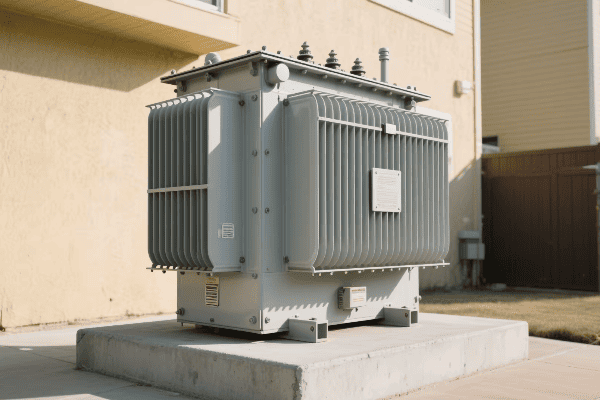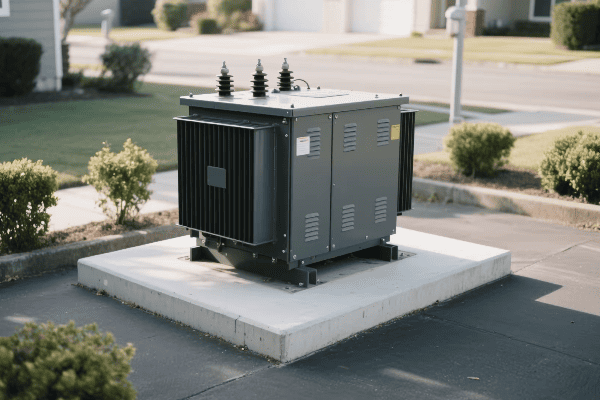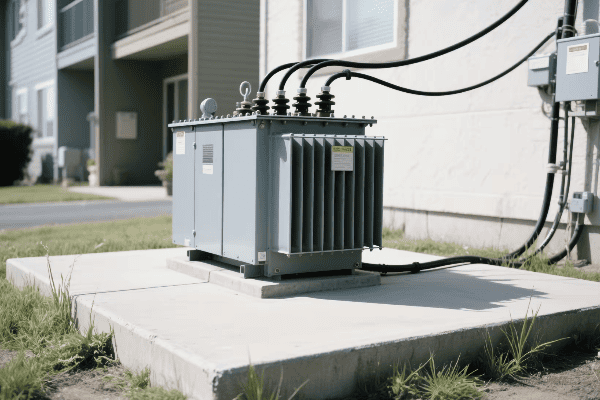How Can We Ensure Safety and Compliance for Pad Mounted Transformer Concrete Pads in Residential Areas?
Are you worried about the safety of electrical installations in your neighborhood? Pad mounted transformers are common, but their concrete pads need careful attention.
Ensuring safety and compliance for pad mounted transformer concrete pads in residential areas involves proper design, installation, and maintenance. This includes meeting specific dimensions, load-bearing capacity, and drainage requirements while adhering to local electrical codes and First Energy standards.

In this article, we’ll explore the key aspects of pad mounted transformer concrete pads. We’ll cover design considerations, safety features, and compliance requirements. Whether you’re a homeowner, contractor, or utility worker, this information is crucial for maintaining a safe and reliable power distribution system.
How Have Power Transformers Evolved from Traditional to Electronic in the Digital Era?
Remember those big, noisy transformers in metal boxes? They’re becoming a thing of the past. The digital age is bringing sleek, smart transformers to our neighborhoods.
Power transformers have evolved from traditional oil-filled units to electronic solid-state devices. This shift brings improved efficiency, smaller size, better power quality, and smart grid compatibility, meeting the growing demands of our digital world.

Let’s dive deeper into this transformation:
The Old Guard: Traditional Transformers
Traditional transformers have served us well for decades, but they have limitations in our digital age.
Characteristics of Traditional Transformers:
- Large and heavy
- Oil-filled for cooling and insulation
- Fixed voltage ratios
- Limited control options
The New Wave: Electronic Transformers
Electronic transformers, also known as solid-state transformers, are changing the game.
Features of Electronic Transformers:
- Compact and lightweight
- Dry-type or advanced cooling systems
- Dynamic voltage regulation
- Advanced control and monitoring capabilities
Key Differences and Advantages
The shift to electronic transformers brings several benefits:
| Aspect | Traditional Transformer | Electronic Transformer |
|---|---|---|
| Size | Large | Compact |
| Weight | Heavy | Lightweight |
| Efficiency | Good | Excellent |
| Power Quality | Basic | Advanced |
| Smart Grid Integration | Limited | Extensive |
| Maintenance | Regular oil checks | Minimal maintenance |
I remember working on a project to upgrade a residential area’s power distribution system. We replaced several old pad mounted transformers with new electronic ones. The difference was striking. Not only did we save space, but we also improved power quality and reduced maintenance needs.
One particular installation stands out. We were dealing with a tight space between two houses. The old transformer barely fit, and accessing it for maintenance was a nightmare. With the new electronic transformer, we not only had plenty of room but also gained the ability to monitor its performance remotely. This meant fewer site visits and quicker response times to any issues.
The residents were initially skeptical about the change, but they quickly appreciated the benefits. The new transformer was quieter, took up less space in their yard, and provided more stable power for their increasingly digital homes.
This experience showed me firsthand the advantages of electronic transformers in residential settings. As our homes become smarter and our energy needs more complex, these advanced transformers will play a crucial role in delivering reliable, high-quality power.
What Advanced Technologies Are Enhancing Electronic Power Transformer Efficiency?
Ever wondered how modern transformers can be so small yet so powerful? The secret lies in cutting-edge technology that’s revolutionizing the industry.
Advanced technologies enhancing electronic power transformer efficiency include wide-bandgap semiconductors, nanocrystalline core materials, digital control systems, and advanced cooling techniques. These innovations reduce losses, improve power density, and enable smarter operation.

Let’s explore these technologies in detail:
Wide-Bandgap Semiconductors: The Power Players
Wide-bandgap semiconductors like Silicon Carbide (SiC) and Gallium Nitride (GaN) are game-changers.
Benefits of Wide-Bandgap Semiconductors:
- Higher switching frequencies
- Lower switching losses
- Better thermal performance
Nanocrystalline Core Materials: Magnetic Marvels
Nanocrystalline materials are pushing the boundaries of magnetic core efficiency.
Advantages of Nanocrystalline Cores:
- Reduced core losses
- Higher magnetic permeability
- Improved performance at high frequencies
Digital Control Systems: The Brains of the Operation
Advanced digital controls make transformers smarter than ever.
Capabilities of Digital Control Systems:
- Real-time monitoring and adjustment
- Predictive maintenance
- Integration with smart grid systems
Advanced Cooling Techniques: Keeping It Cool
Innovative cooling methods help manage heat in compact designs.
Modern Cooling Solutions:
- Phase-change materials
- Advanced heat sink designs
- Liquid cooling for high-power applications
| Technology | Efficiency Impact | Implementation Challenges |
|---|---|---|
| Wide-Bandgap Semiconductors | High | Cost, thermal management |
| Nanocrystalline Cores | Medium-High | Manufacturing complexity |
| Digital Control Systems | Medium | Software development, cybersecurity |
| Advanced Cooling | Medium-High | Design complexity, cost |
I once worked on a project to develop a new line of electronic transformers for a utility company. We faced the challenge of increasing efficiency while reducing size. The breakthrough came when we combined SiC semiconductors with a nanocrystalline core.
The results were impressive. We achieved a 30% reduction in size and a 20% improvement in efficiency compared to traditional designs. The utility company was thrilled, as this meant they could upgrade more locations without needing to expand transformer pads.
However, implementing these technologies wasn’t without challenges. The cost of SiC components was initially high, and working with nanocrystalline materials required new manufacturing processes. We had to balance the benefits against the increased production costs.
One particular hurdle was thermal management. The compact design meant we had less space for heat dissipation. We solved this by developing a hybrid cooling system that combined passive heat sinks with active liquid cooling for peak load periods.
This project taught me the importance of holistic design in electronic transformers. Each technology brings its own benefits and challenges. The key is to integrate them in a way that maximizes overall performance while remaining cost-effective.
As these technologies continue to evolve, I’m excited about the possibilities for even more efficient and capable electronic transformers. The future of power distribution is smaller, smarter, and more efficient than ever before.
How Do We Measure and Evaluate Efficiency in Electronic Power Transformers Using Modern Metrics and Methods?
Are you still using outdated methods to check transformer efficiency? In the world of electronic power transformers, we need new tools for the job.
Measuring efficiency in electronic power transformers involves advanced metrics like total harmonic distortion (THD), power factor, and dynamic response. Modern methods include real-time monitoring, power quality analyzers, and sophisticated simulation tools to capture performance under various conditions.

Let’s dive into the modern approach to measuring transformer efficiency:
Beyond Traditional Efficiency Metrics
Old-school efficiency tests don’t tell the whole story for electronic transformers.
Traditional Metrics (Still Important):
- No-load losses
- Load losses
- Efficiency at rated load
New Efficiency Metrics for the Digital Age
Electronic transformers require a more comprehensive set of measurements.
Modern Efficiency Metrics:
- Total Harmonic Distortion (THD)
- Power Factor
- Dynamic Efficiency under Variable Loads
- Standby Power Consumption
Cutting-Edge Measurement Techniques
New technologies allow for more accurate and comprehensive efficiency evaluations.
Modern Measurement Methods:
- Real-time power quality analyzers
- High-precision wideband power meters
- Thermal imaging for loss analysis
- Advanced oscilloscopes for waveform analysis
| Metric | What It Measures | Why It’s Important |
|---|---|---|
| THD | Harmonic content in output | Indicates power quality |
| Power Factor | Ratio of real to apparent power | Reflects overall system efficiency |
| Dynamic Efficiency | Performance under varying loads | Mimics real-world conditions |
| Standby Power | Energy consumption when idle | Critical for always-on systems |
I remember a challenging project where we were troubleshooting efficiency issues in a newly installed electronic transformer at a data center. Traditional efficiency tests showed good results, but the client was experiencing unexplained power quality issues.
We brought in state-of-the-art power quality analyzers and set up continuous monitoring. What we discovered was eye-opening. While the transformer performed well under steady-state conditions, it struggled with the highly variable loads typical of data center operations.
The real culprit was harmonic distortion. The transformer’s output had significant THD during peak usage times, which wasn’t captured by standard efficiency tests. This distortion was causing issues with sensitive IT equipment.
To solve the problem, we had to rethink our approach to efficiency. We implemented a dynamic testing protocol that simulated real-world load variations. We also added continuous THD monitoring to the transformer’s control system.
The result was a much more accurate picture of the transformer’s performance. We were able to fine-tune the control algorithms to better handle load variations and reduce harmonic distortion. This not only improved efficiency but also solved the client’s power quality issues.
This experience taught me the importance of comprehensive, real-world testing for electronic transformers. In today’s digital environment, efficiency isn’t just about power in versus power out. It’s about delivering clean, stable power under all conditions.
As we continue to push the boundaries of electronic transformer technology, our measurement and evaluation techniques must evolve too. Only by using the most advanced metrics and methods can we ensure that our transformers are truly up to the task of powering our digital world.
How Can We Optimize Electronic Power Transformer Design for Maximum Energy Conversion in Digital Applications?
Are your transformers keeping up with the digital revolution? In today’s high-tech world, every watt counts. Let’s explore how to squeeze maximum performance from electronic transformers.
Optimizing electronic power transformer design for digital applications involves using advanced materials, implementing sophisticated control algorithms, and adopting modular architectures. These strategies enhance energy conversion efficiency, improve thermal management, and provide the flexibility needed for diverse digital loads.

Let’s dive into the strategies for creating the ultimate digital-age transformer:
Advanced Materials: The Building Blocks of Efficiency
Choosing the right materials can make or break a transformer’s performance.
Key Material Innovations:
- Nanocrystalline and amorphous core materials
- High-performance insulation systems
- Advanced semiconductor materials (SiC, GaN)
Smart Control Systems: The Brains of the Operation
Intelligent control is essential for handling the complex loads of digital applications.
Control Strategies:
- Adaptive voltage regulation
- Dynamic power factor correction
- Predictive load management
Modular Design: Flexibility Meets Efficiency
A one-size-fits-all approach doesn’t work in the digital world. Modular designs are the answer.
Benefits of Modularity:
- Scalability for different power requirements
- Easy maintenance and upgrades
- Improved fault tolerance
Thermal Management: Keeping Cool Under Pressure
Efficient cooling is crucial for maintaining performance and longevity.
Cooling Innovations:
- Phase-change materials
- Advanced heat sink designs
- Liquid cooling for high-power applications
| Design Aspect | Impact on Efficiency | Implementation Complexity |
|---|---|---|
| Advanced Materials | High | Medium |
| Smart Control Systems | High | High |
| Modular Design | Medium | Medium |
| Thermal Management | Medium-High | Medium-High |
I once worked on a project to design a new electronic transformer for a major tech company’s data center. They needed a solution that could handle their rapidly changing power demands while maintaining high efficiency.
We started with a nanocrystalline core material, which reduced our core losses significantly. But the real challenge was dealing with the variable loads. Traditional transformers would struggle with the rapid changes in power demand as servers spun up and down.
Our solution was to implement a modular design with advanced control algorithms. We created smaller transformer modules that could be dynamically engaged or disengaged based on the current load. This allowed us to maintain high efficiency across a wide range of power demands.
The control system was the key to making this work. We developed an AI-driven predictive load management system that could anticipate power needs based on historical data and current trends. This allowed the transformer to proactively adjust its configuration for optimal efficiency.
Thermal management was another crucial aspect. The compact design and high power density meant we needed an innovative cooling solution. We ended up using a combination of phase-change materials for passive cooling and a liquid cooling system for handling peak loads.
The result was a transformer that not only met the client’s efficiency goals but also provided the flexibility they needed for their dynamic environment. Energy conversion efficiency improved by 15% compared to their previous solution, and the modular design meant they could easily scale up as their data center grew.
This project taught me that optimizing electronic transformers for digital applications is about more than just using the latest materials or the most powerful semiconductors. It’s about creating a holistic design that can adapt to the unique challenges of the digital world.
As we continue to push the boundaries of what’s possible with electronic transformers, I’m excited to see how these optimization strategies will evolve. The future of power conversion in digital applications is bright, efficient, and incredibly adaptable.
What Role Do Efficient Electronic Power Transformers Play in Smart Grids and Renewable Energy Systems?
Ever wondered how we’ll power the smart cities of tomorrow? Efficient electronic power transformers are a key piece of the puzzle, bridging the gap between traditional power systems and the renewable future.
Efficient electronic power transformers are crucial in smart grids and renewable energy systems. They enable bidirectional power flow, provide voltage stabilization, improve power quality, and facilitate the integration of intermittent renewable sources. These transformers are the backbone of a more flexible and resilient power infrastructure.

Let’s explore how these transformers are shaping our energy future:
Enabling Bidirectional Power Flow
Electronic transformers act as the traffic controllers of the modern grid.
Key Functions:
- Support for distributed energy resources
- Facilitation of peer-to-peer energy trading
- Enhanced grid flexibility
Voltage Stabilization in Variable Renewable Systems
Keeping the voltage steady is crucial with fluctuating renewable inputs.
Stabilization Techniques:
- Dynamic voltage regulation
- Reactive power compensation
- Fast response to sudden changes in generation or load
Power Quality Improvement
These transformers are the guardians of clean power in our increasingly electronic world.
Power Quality Enhancements:
- Harmonic mitigation
- Flicker reduction
- Fault current limiting
Grid Balancing and Energy Storage Integration
Electronic transformers help keep the grid in perfect harmony.
Balancing Capabilities:
- Load shifting
- Frequency regulation
- Seamless integration with battery storage systems
| Function | Impact on Smart Grids | Impact on Renewable Integration |
|---|---|---|
| Bidirectional Power Flow | Enables prosumer participation | Facilitates distributed generation |
| Voltage Stabilization | Improves grid reliability | Manages intermittency of renewables |
| Power Quality Improvement | Enhances overall system efficiency | Ensures compliance with grid codes |
| Grid Balancing | Optimizes energy distribution | Supports higher renewable penetration |
I recently worked on a fascinating project integrating a large solar farm into a regional grid. The electronic transformers we installed were the unsung heroes of the operation. They handled the variable output of the solar panels with ease, maintaining stable voltage and high power quality.
One sunny day, we faced an unexpected challenge. A sudden cloud cover caused the solar farm’s output to drop by 70% in just minutes. In a traditional system, this could have caused significant grid instability. But our electronic transformers sprang into action.
The transformers quickly adjusted their settings, drawing power from nearby energy storage systems and the main grid to compensate for the loss. They balanced the load seamlessly, ensuring that consumers didn’t experience any interruption in their power supply.
What impressed me most was the speed and precision of the response. The transformers communicated with each other and with the grid control system in real-time, making micro-adjustments to maintain optimal power flow.
This experience reinforced my belief in the critical role of efficient electronic transformers in our future energy systems. They’re not just passive components but active players in managing and optimizing our increasingly complex and distributed power networks.
As we move towards a more sustainable and intelligent energy future, the importance of these advanced transformers will only grow. They are the enablers of smart grids and the key to unlocking the full potential of renewable energy sources.
The project also highlighted the need for continued innovation in this field. As renewable energy penetration increases and our grids become more complex, we’ll need even more advanced transformer technologies. I’m excited to be part of this evolution, working on transformers that will power the sustainable cities of tomorrow.
Conclusion
Efficient electronic power transformers are revolutionizing our energy landscape. They play a crucial role in ensuring safety, improving efficiency, and enabling the integration of renewable energy sources. As we move towards smarter grids and more sustainable power systems, these advanced transformers will continue to be at the forefront of innovation.
Free CHBEB Transformer Catalog Download
Get the full range of CHBEB transformers in one catalog.
Includes oil-immersed, dry-type, pad-mounted, and custom solutions.
Quick Message
Request A free quote
We'd like to work with you
- +86 15558785111
- [email protected]
- +86 15558785111
What We Do
CHINA BEI ER BIAN (CHBEB) GROUP, with 218 million in registered capital, originated from Beijing Beierbian Transformer Group. Headquartered in Beijing for R&D, it operates major production bases in Nanjing and Yueqing, producing high-quality products.
Latest Product
address
BeiJing
No 3,RongJing East Road,BeiJing Economic Technological Development Area,BeiJing,China
JiangSu
No 7️Xiangfeng Road,Jiangning,NanJing,JiangSu,China
WenZhou
No.211, Wei 16 Road, Industrial Zone, Yueqing, Wenzhou, Zhejiang, China.
XiangYang Industrial Zone ,YueQing,WenZhou,ZheJiang,China
contact us
- [email protected]
- +86 13057780111
- +86 13057780111
- +86 15558785111
Copyright © Bei Er Bian Group


